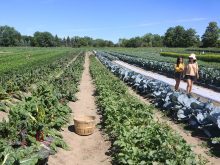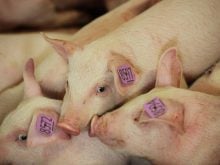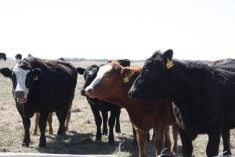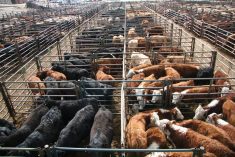Bertie Van Zyl’s cattle have enabled him to travel around the world and see a variety of Pinzgauer styles, but one thing never changes.
The distinctive white tail and rear end always dominate whether he visits Pinzgauer ranches in Brazil or Zimbabwe.
President of the International Pinzgauer Congress since 1993, Van Zyl lives in South Africa where his family raised 2,000 Pinzgauer purebred and influenced cows. Last year due to severe drought he culled his herd back to 600 purebred cows.
He was at the Calgary Stampede Pinzgauer show to help celebrate the breed’s world congress.
Read Also

VIDEO: Ag in Motion documentary launches second season
The second season of the the Western Producer’s documentary series about Ag in Motion launched Oct. 8.
The South Africans often cross Pinzgauers with Brahman cattle for heat and insect resistance. The mating results in cattle with big, floppy ears but the white tails are always obvious.
Van Zyl prefers longer cattle than the Canadian type, which tend to have heavier muscling and deeper bodies. He is also looking for pigmentation on the face and teats. South African conditions cause sunburn so he wants cattle with their own sunscreen.
Pinzgauers came from Austria, where they were raised for meat and milk, but breeders from other countries prefer them for beef.
“It’s the best marbled meat and in South Africa, they are the best feed utilizers,” he said.
The recent discovery that a majority of Pinzgauers carry a double tenderness gene could be a major sales point in the future, said Pam Shay-Bryant of Tennessee.
A guarantee of tenderness along with a reputation for docility could help sell the breed.
“If it were up to the women of the world, the cattle would all be Pinzgauers because they are so docile and pretty,” she said.
The Stampede show was the largest purebred beef show this year, but numbers were down because Americans attending the Calgary congress could not bring cattle to show due to bovine spongiform encephalopathy closing the border.
Shay-Bryant was disappointed her cattle had to stay home.
“We were already in quarantine and we were prevented from arriving. We could give these Canadians some good competition,” she said.
This year’s show offered some black and white animals. Canada accepts blacks and will register them in its herd book but they are not registered in some other countries. Black Pinzgauers are not shown in the U.S., said Donna Smith of Olds, Alta.
She and her husband, Gary, joined the Pinzgauer business 22 years ago after they saw a neighbour trailing the distinctive coloured cattle back and forth past their farm. The calves improved so much over the summer, they decided it was the breed for them.
“We thought they were just excellent calves,” she said.
They formed Diamond T Pinzgauers and at this year’s show won grand champion honours for the best bull, cow and breeders’ herd.
They bought their first animals from the Canadian Pinzgauer company owned by Dave and Irene Morgan. They imported the cattle from Europe and sold them to Canadians when the animals were first allowed in 30 years ago.
The breed has existed for about 400 years and the Austrian herd records started around the 18th century. The Pinzgauer name stems from their birthplace in the Pinzgau valley in Salzburg, Austria.
Developed as a dual purpose breed from Bavarian red cattle, Pinzgauer possess a combination of high milk production and fattening qualities. Alpine grazing and harsh weather conditions generated a strong constitution, ranging ability and soundness. Unusually thick hides provide resistance to insects and dark eye pigmentation virtually eliminates eye disease.

















